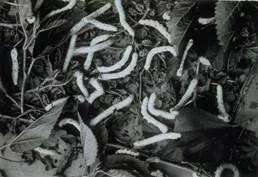View Other Topics.
 Jun 8, 2016
Jun 8, 2016
Image: Silkworms, Cheney Brothers, Manchester, ca.
1900 – Connecticut Historical Society and
Connecticut History Illustrated
In this extensive article By Bob Wyss for Connecticut Explored we find that Connecticut was the center of a short-lived cottage industry producing silk!
Spreading its leafy limbs before the former Mansfield Town Hall is a tree of a non-native species that once covered many of the hills and valleys of Connecticut—a black mulberry. And almost directly across Storrs Road on Route 195 bordering the Altnaveigh Inn stands a second, a white mulberry.
Two hundred years ago tens of thousands of cultivated mulberry trees dotted the Connecticut landscape. Few have survived the ravages of time, the harsh Connecticut climate, blight, and the foibles of mankind. Those that remain are relics of a strange chapter in Connecticut’s history, one that featured a fabled fabric, get-rich-quick dreams spun by promoters, hucksters, and swindlers, and, finally, panic and ruin. It is the story of a burgeoning but short-lived cottage industry that was unique in the young, 19th-century American nation.
The story begins with the mulberry tree and the silkworm, which is a type of caterpillar. The silkworm prefers a diet of mulberry leaves. It produces a cocoon which, when unraveled, can be spun into silk thread. The process of silk production is called sericulture, and 200 years ago Connecticut, especially Windham and Tolland Counties, was the epicenter of US raw-silk production.
Tags:
#mulberry#craze,#silk,#silkworms,#cheney#brothers,#caterpillars,#starzpsychics.com,advisors
Connecticut’s Mulberry Craze .

Image: Silkworms, Cheney Brothers, Manchester, ca.
1900 – Connecticut Historical Society and
Connecticut History Illustrated
In this extensive article By Bob Wyss for Connecticut Explored we find that Connecticut was the center of a short-lived cottage industry producing silk!
Spreading its leafy limbs before the former Mansfield Town Hall is a tree of a non-native species that once covered many of the hills and valleys of Connecticut—a black mulberry. And almost directly across Storrs Road on Route 195 bordering the Altnaveigh Inn stands a second, a white mulberry.
Two hundred years ago tens of thousands of cultivated mulberry trees dotted the Connecticut landscape. Few have survived the ravages of time, the harsh Connecticut climate, blight, and the foibles of mankind. Those that remain are relics of a strange chapter in Connecticut’s history, one that featured a fabled fabric, get-rich-quick dreams spun by promoters, hucksters, and swindlers, and, finally, panic and ruin. It is the story of a burgeoning but short-lived cottage industry that was unique in the young, 19th-century American nation.
The story begins with the mulberry tree and the silkworm, which is a type of caterpillar. The silkworm prefers a diet of mulberry leaves. It produces a cocoon which, when unraveled, can be spun into silk thread. The process of silk production is called sericulture, and 200 years ago Connecticut, especially Windham and Tolland Counties, was the epicenter of US raw-silk production.
Share this article with friends!
Tags:
#mulberry#craze,#silk,#silkworms,#cheney#brothers,#caterpillars,#starzpsychics.com,advisors






